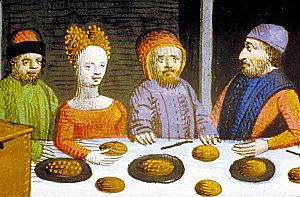Frumenty facts for kids

Diners eating frumenty, Bartholomeus Anglicus
|
|
| Alternative names | Frumentee, furmity, fromity, fermenty |
|---|---|
| Type | Pudding |
| Main ingredients | Wheat, milk, eggs or broth |
Frumenty was a very popular dish in Western Europe during the Middle Ages. It's a type of porridge, which is a thick meal made from boiled grains. The name "Frumenty" comes from the Latin word frumentum, meaning "grain."
This dish was usually made with cracked wheat boiled in milk or broth. It was a common food for everyday people. However, fancier versions could include eggs, almonds, currants, sugar, saffron, and even orange flower water. Frumenty was often served with meat, like venison. Sometimes it was even eaten with porpoise, which was considered a "fish" and allowed during Lent (a time when people didn't eat meat). Frumenty was also used as a "subtlety," a special dish served between courses at big banquets.
Contents
Frumenty in England
A Look at History
Florence White, who started the English Folk Cookery Association, once called frumenty England's "oldest national dish." For many centuries, frumenty was a traditional part of the Christmas meal in Celtic areas.
In Yorkshire, people traditionally ate frumenty on Christmas Eve. An old book from 1822 mentions that it was always served, from fancy homes to simple cottages. It was often eaten along with "yule cake" and other festive foods.
Frumenty was also a special dish for Mothering Sunday. This day is the fourth Sunday of Lent, usually in late spring. Many servants were allowed to visit their mothers on this day. They were often given frumenty to celebrate and to give them a healthy meal before their journey back. Eating eggs in the frumenty was a nice break from the Lenten fast.
In Lincolnshire, frumenty was linked to sheep-shearing in June. One person remembered from the 1820s that farmers would make a lot of frumenty when they started clipping sheep. Every child in the village was invited to eat some. Later, a better batch was made and shared with every house.
Food expert Polly Russell found one of the first English recipes for frumenty in a book from the 1390s called The Forme of Cury. This old recipe even inspired a modern Christmas menu at a famous restaurant!
How Frumenty Was Made
Steve Roud, a librarian and expert on folklore, collected several recipes for frumenty in his book The English Year. These recipes show how much the dish could change depending on the place and time.
Here are some ways it was prepared:
- Recipe 1: People would partly boil whole wheat grains in water. Then, they would drain the water and boil the wheat in milk. Finally, they would sweeten it with sugar and add spices like cinnamon.
- Recipe 2: This recipe involved taking clean wheat and beating it in a mortar. This helped remove the outer husks. Then, the wheat was boiled until it burst open. After cooling, it was mixed with fresh broth and either almond milk or cow's milk. Egg yolks were added, and the mixture was boiled a little more. It was often served with fatty venison or fresh mutton.
- Recipe 3 (Somerset-Wiltshire): About 40 years before this recipe was written, country women would bring basins of new wheat, boiled until it was like jelly, to market. This wheat was then put into a large pot with milk, eggs, and sultanas. It was lightly cooked and then poured into pie dishes. This version was served on Mid-Lent Sunday and the week after. Frumenty is still made in Devizes for Mothering Sunday.
Sometimes, a bit of spirit was also mentioned as being served with frumenty.
Frumenty Around the World
A similar dish, made with boiled cracked wheat and sour milk, was eaten in ancient Persia. Today, similar dishes are still enjoyed in other countries. For example, in Greece and Cyprus, it's called trahanas, and in Turkey, it's known as tarhana. These are often used as a base for soups. Kutia is another dish from Eastern Europe that has a very similar recipe to frumenty.
See also
 In Spanish: Frumenty para niños
In Spanish: Frumenty para niños

